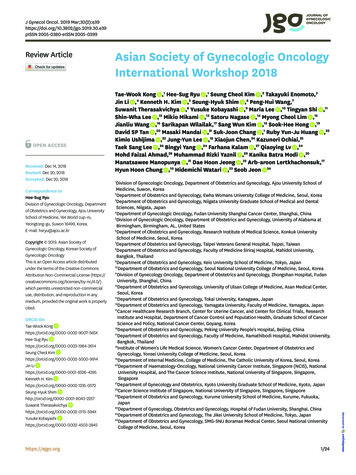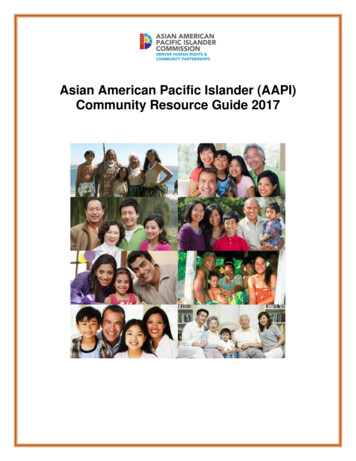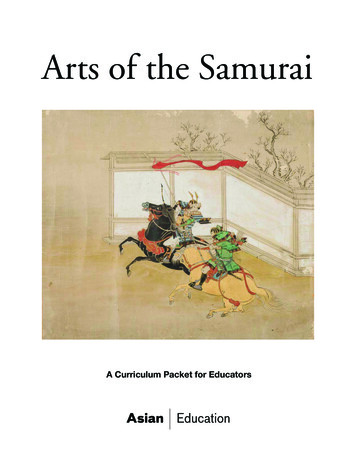
Transcription
J Gynecol Oncol. 2019 39pISSN 2005-0380·eISSN 2005-0399Review ArticleReceived: Dec 14, 2018Revised: Dec 20, 2018Accepted: Dec 20, 2018Correspondence toHee-Sug RyuDivision of Gynecologic Oncology, Departmentof Obstetrics and Gynecology, Ajou UniversitySchool of Medicine, 164 World cup-ro,Yeongtong-gu, Suwon 16499, Korea.E-mail: hsryu@ajou.ac.krCopyright 2019. Asian Society ofGynecologic Oncology, Korean Society ofGynecologic OncologyThis is an Open Access article distributedunder the terms of the Creative CommonsAttribution Non-Commercial License hich permits unrestricted non-commercialuse, distribution, and reproduction in anymedium, provided the original work is properlycited.ORCID iDsTae-Wook Konghttps://orcid.org/0000-0002-9007-565XHee-Sug Ryuhttps://orcid.org/0000-0003-1984-2614Seung Cheol Kimhttps://orcid.org/0000-0002-5000-9914Jin Lihttps://orcid.org/0000-0001-8526-4395Kenneth H. Kimhttps://orcid.org/0000-0002-1235-0572Seung-Hyuk Shimhttp://orcid.org/0000-0001-8043-2257Suwanit XYusuke s://ejgo.orgAsian Society of Gynecologic OncologyInternational Workshop 2018Tae-Wook Kong ,1 Hee-Sug Ryu ,1 Seung Cheol Kim ,2 Takayuki Enomoto,3Jin Li ,4 Kenneth H. Kim ,5 Seung-Hyuk Shim ,6 Peng-Hui Wang,7Suwanit Therasakvichya ,8 Yusuke Kobayashi ,9 Maria Lee ,10 Tingyan Shi ,11Shin-Wha Lee ,12 Mikio Mikami ,13 Satoru Nagase ,14 Myong Cheol Lim ,15Jianliu Wang ,16 Sarikapan Wilailak,17 Sang Wun Kim ,18 Sook-Hee Hong ,19David SP Tan ,20 Masaki Mandai ,21 Suk-Joon Chang ,1 Ruby Yun-Ju Huang ,22Kimio Ushijima ,23 Jung-Yun Lee ,18 Xiaojun Chen,24 Kazunori Ochiai,25Taek Sang Lee ,26 Bingyi Yang ,24 Farhana Kalam ,27 Qiaoying Lv ,24Mohd Faizal Ahmad,28 Muhammad Rizki Yaznil ,29 Kanika Batra Modi ,30Manatsawee Manopunya ,31 Dae Hoon Jeong ,32 Arb-aroon Lertkhachonsuk,17Hyun Hoon Chung ,10 Hidemichi Watari ,33 Seob Jeon 34Division of Gynecologic Oncology, Department of Obstetrics and Gynecology, Ajou University School ofMedicine, Suwon, Korea2Department of Obstetrics and Gynecology, Ewha Womans University College of Medicine, Seoul, Korea3 Department of Obstetrics and Gynecology, Niigata University Graduate School of Medical and DentalSciences, Niigata, Japan4 Department of Gynecologic Oncology, Fudan University Shanghai Cancer Center, Shanghai, China5 Division of Gynecologic Oncology, Department of Obstetrics and Gynecology, University of Alabama atBirmingham, Birmingham, AL, United States6 Department of Obstetrics and Gynecology, Research Institute of Medical Science, Konkuk UniversitySchool of Medicine, Seoul, Korea7Department of Obstetrics and Gynecology, Taipei Veterans General Hospital, Taipei, Taiwan8 Department of Obstetrics and Gynecology, Faculty of Medicine Siriraj Hospital, Mahidol University,Bangkok, Thailand9Department of Obstetrics and Gynecology, Keio University School of Medicine, Tokyo, Japan10Department of Obstetrics and Gynecology, Seoul National University College of Medicine, Seoul, Korea11 Division of Gynecology Oncology, Department of Obstetrics and Gynecology, Zhongshan Hospital, FudanUniversity, Shanghai, China12 Department of Obstetrics and Gynecology, University of Ulsan College of Medicine, Asan Medical Center,Seoul, Korea13Department of Obstetrics and Gynecology, Tokai University, Kanagawa, Japan14Department of Obstetrics and Gynecology, Yamagata University, Faculty of Medicine, Yamagata, Japan15 Cancer Healthcare Research Branch, Center for Uterine Cancer, and Center for Clinical Trials, ResearchInstitute and Hospital, Department of Cancer Control and Population Health, Graduate School of CancerScience and Policy, National Cancer Center, Goyang, Korea16Department of Obstetrics and Gynecology, Peking University People's Hospital, Beijing, China17 Department of Obstetrics and Gynecology, Faculty of Medicine, Ramathibodi Hospital, Mahidol University,Bangkok, Thailand18 Institute of Women's Life Medical Science, Women's Cancer Center, Department of Obstetrics andGynecology, Yonsei University College of Medicine, Seoul, Korea19Department of Internal Medicine, College of Medicine, The Catholic University of Korea, Seoul, Korea20 Department of Haematology-Oncology, National University Cancer Institute, Singapore (NCIS), NationalUniversity Hospital, and The Cancer Science Institute, National University of Singapore, Singapore,Singapore21Department of Gynecology and Obstetrics, Kyoto University Graduate School of Medicine, Kyoto, Japan22Cancer Science Institute of Singapore, National University of Singapore, Singapore, Singapore23 Department of Obstetrics and Gynecology, Kurume University School of Medicine, Kurume, Fukuoka,Japan24Department of Gynecology, Obstetrics and Gynecology, Hospital of Fudan University, Shanghai, China25Department of Obstetrics and Gynecology, The Jikei University School of Medicine, Tokyo, Japan26 Department of Obstetrics and Gynecology, SMG-SNU Boramae Medical Center, Seoul National UniversityCollege of Medicine, Seoul, Korea1 1/24
ASGO International Workshop 2018Maria Leehttps://orcid.org/0000-0002-8017-3176Tingyan Shihttps://orcid.org/0000-0002-5356-0365Shin-Wha Leehttps://orcid.org/0000-0002-5088-1905Mikio Mikamihttps://orcid.org/0000-0002-7496-3518Satoru Nagasehttps://orcid.org/0000-0001-7894-0914Myong Cheol Limhttp://orcid.org/0000-0001-8964-7158Jianliu Wanghttps://orcid.org/0000-0001-8932-317XSang Wun Kimhttps://orcid.org/0000-0002-8342-8701Sook-Hee Honghttps://orcid.org/0000-0003-4299-5694David SP Tanhttps://orcid.org/0000-0001-9087-5262Masaki n Changhttp://orcid.org/0000-0002-0558-0038Ruby Yun-Ju Huanghttps://orcid.org/0000-0001-6376-3185Kimio Yun Leehttps://orcid.org/0000-0001-7948-1350Taek Sang Leehttps://orcid.org/0000-0001-8119-5601Bingyi Yanghttps://orcid.org/0000-0003-1583-3892Farhana Kalamhttps://orcid.org/0000-0002-6427-863XQiaoying Lvhttps://orcid.org/0000-0003-3610-2538Muhammad Rizki Yaznilhttps://orcid.org/0000-0003-1402-2385Kanika Batra e Manopunyahttps://orcid.org/0000-0002-5123-1402Dae Hoon Jeonghttps://orcid.org/0000-0001-9464-5763Hyun Hoon i Watarihttps://orcid.org/0000-0002-4189-6187Seob Jeonhttps://orcid.org/0000-0001-5230-1997Conflict of interestNo potential conflict of interest relevant to thisarticle was reported.https://ejgo.orgNational Institute of Cancer Research and Hospital, Mohakhali, Dhaka, BangladeshDepartment of Obstetrics and Gynaecology, Universiti Kebangsaan Malaysia Medical Center, KualaLumpur, Malaysia29 Gynecoogic Oncology Division, Obstetrics and Gynecologic Department, H. Adam Malik General Hospital– Universitas Sumatera Utara, Medan, Indonesia30Max Institute of Cancer Care, Saket, New Delhi, India31 Division of Gynecologic Oncology, Department of Obstetrics and Gynecology, Faculty of Medicine, ChiangMai University, Chiang Mai, Thailand32Busan Paik Hospital, Paik Institute for Clinical Research, Inje University, Busan, Korea33 Department of Obstetrics and Gynaecology, Hokkaido University Graduate School of Medicine, Sapporo,Japan34 Department of Obstetrics and Gynecology, Soonchunhyang University Cheonan Hospital, SoonchunhyangUniversity College of Medicine, Cheonan, Korea2728 ABSTRACTThe Asian Society of Gynecologic Oncology International Workshop 2018 on gynecologiconcology was held in the Ajou University Hospital, Suwon, Korea on the 24th to 25th August2018. The workshop was an opportunity for Asian doctors to discuss the latest findingsof gynecologic cancer, including cervical, ovarian, and endometrial cancers, as well asthe future of fertility-sparing treatments, minimally invasive/radical/debulking surgery,radiotherapy, chemotherapy, targeted therapy, and immunotherapy. Clinical guidelines andposition statement of Asian countries were presented by experts. Asian clinical trials forgynecologic cancers were reviewed and experts emphasized the point that original Asianstudy is beneficial for Asian patients. In Junior session, young gynecologic oncologistspresented their latest research on gynecologic cancers.Keywords: Uterine Cervical Neoplasms; Ovarian Neoplasms; Endometrial Neoplasms;Radiotherapy; Antineoplastic Agents; ImmunotherapyINTRODUCTIONThe Asian Society of Gynecologic Oncology International Workshop 2018 on gynecologiconcology was held in the Ajou University Hospital, Suwon, Korea on the 24th to 25thAugust 2018. The workshop was an opportunity for Asian doctors to improve theirknowledge of gynecologic cancers and allow all participants to discuss the latestfindings of gynecologic cancer, including cervical, ovarian, and endometrial cancers,as well as the future of minimally invasive/radical/debulking surgery, radiotherapy (RT),hyperthermic intraperitoneal chemotherapy (HIPEC), chemotherapy, targeted therapy, andimmunotherapy. Professor Hee-Sug Ryu (President of ASGO) addressed a special warmwelcome to ASGO members and Professor Ikuo Konishi (Immediate Past President of ASGO)and Young-Tak Kim (President of KSGO) gave congratulatory addresses (Fig. 1). Two hundredand fifty-seven participants from 15 countries and areas (Bangladesh, China, Hong Kong,India, Indonesia, Japan, Korea, Malaysia, Mongolia, Myanmar, Philippines, Singapore,Taiwan, Thailand, and USA) attended the workshop, which comprised 42 presentations in10 sessions [1]. Seung-Cheol Kim (Chairman, Organizing Committee of ASGO InternationalWorkshop) made closing remarks and expressed gratitude to all participants (Fig. 2).https://doi.org/10.3802/jgo.2019.30.e392/24
ASGO International Workshop 2018Fig. 1. Welcome and congratulatory addresses. From left to right, Hee-Sug Ryu (President of ASGO), Ajou University School of Medicine, Republic of Korea; IkuoKonishi (Immediate Past President of ASGO), National Hospital Organization Kyoto Medical Center, Japan; Young-Tak Kim (President of KSGO), Asan MedicalCenter, Republic of Korea.Fig. 2. Banquet and closing ceremony. Closing remarks by Seung-Cheol Kim (Chairman, Organizing Committee of ASGO International Workshop), Ewha WomansUniversity Cancer Center for Women, Republic of Korea.Author ContributionsInvestigation: K.T.W., R.H.S.; Visualization:K.T.W., R.H.S.; Writing - original draft: K.T.W.,R.H.S.; Writing - review & editing: K.T.W.,R.H.S., K.S.C., E.K., L.J., K.K.H., S.S.H., W.P.H.,T.S., K.Y., L.M., S.T., L.S.W., M.M., N.S., L.M.C.,W.J., W.S., K.S.W., H.S.H., T.D.S., M.M., C.S.J.,H.R.Y., U.K., L.J.Y., C.X., O.K., L.T.S., Y.B., K.F.,L.Q., A.M.F., Y.M.R., M.K.B., M.M., J.D.H., L.A.,C.H.H., W.H., J.S.SESSION A-1. CERVICAL CANCER1. Effectiveness of national HPV vaccination program for Japanese youngwomenIn April 2013, both the bivalent and quadrivalent human papilloma virus (HPV) vaccineswere included in the Japanese National Immunization Program. However, only two monthslater, in June 2013, the Japanese Ministry of Health, Labor, and Welfare suspended proactiverecommendations for the HPV vaccine after unconfirmed reports of adverse events. TheNiigata study showed a high vaccine effectiveness of the bivalent vaccine against vaccinetargeted high risk-HPV types (i.e., HPV 16 and 18) and significant cross-protection againstpooled high risk-HPV types 31, 45 and 52, which are associated with an additional 10%of invasive cervical cancer in Japan [2]. Recently, the Cochrane Library review into theeffectiveness and safety of the HPV vaccine demonstrated that the vaccine causes no seriousside effects [3]. Takayuki Enomoto concluded that the bivalent vaccines may be able toprevent approximately 82% of invasive cervical cancer in Japan and are safe with no seriousadverse effects (Supplementary Fig. 1).2. All about trachelectomyRadical trachelectomy is an option for cervical cancer stage IA2 or IB1 patients wishing topreserve fertility, but typically only for tumors 2 cm or less. Some studies have examinedabdominal radical trachelectomy in patients with larger stage IB1 tumors ranging from 2 to4 cm in diameter and reported safe oncologic outcomes [4-6]. However, obstetric .2019.30.e393/24
ASGO International Workshop 2018after abdominal radical trachelectomy were not favorable because more patients in this groupmay require adjuvant therapy, reducing fertility. Thus, Jin Li suggested that neoadjuvantchemotherapy (NACT) can be used in patients with tumors 2 to 4 cm to reduce tumor sizeso that a less radical fertility-sparing surgery may be offered [7]. Cervical stenosis is a majorand unique complications following radical trachelectomy. The incidence rates of cervicalstenosis ranged from 0% to 73.3% with an average rate of 10.5% [8]. It affects not only thequality of life but also obstetrical outcomes. Jin Li concluded that both the cerclage andthe placement of an anti-stenosis tool can be used to prevent cervical stenosis, but theeffectiveness of these tools needs further studies (Supplementary Fig. 1).3. Revisiting Sedlis criteria: can we do better?Sedlis criteria have been used for decades in the treatment of early-stage cervical cancerpatients with intermediate-risk factors to improve recurrence-free interval. However, theGOTIC study suggested that RT and concurrent chemoradiation therapy (CCRT) afterradical hysterectomy (RH) were not beneficial in patients with intermediate risk factors. Inparticular, RT and CCRT appeared to increase the incidence of lymphedema [9]. In addition,systemic chemotherapy alone without RT, showed similar outcomes as compared to RT,thus may be an alternative treatment choice for adjuvant therapy in intermediate-risk stageIB cervical cancer [10]. Kenneth H. Kim suggested that there should continue to be activeresearch in this arena, and so perhaps it is time to revisit our criteria for when to treat earlystage cervical cancer patients and how to do so effectively (Supplementary Fig. 1).4. Is minimally invasive surgery (MIS) the real culprit in poor prognosis ofearly-stage cervical cancer?RH using MIS in early cervical cancer has been adopted in the developed countries as thestandard surgical approach. However, the phase III Laparoscopic Approach to CervicalCancer trial revealed that women undergoing MIS RH for early cervical cancer had higherrates of disease recurrence and worse survival than those who received abdominal RH[11]. Tae-Wook Kong suggested several important factors affecting disease recurrenceafter MIS RH. Three possible factors are circulating CO2 pneumoperitoneum, selection ofoptimal surgical candidates without parametrial invasion, and surgical technique includingcolpotomic approach (Supplementary Fig. 1). In particular, both tumor cut-through andspillage under CO2 pneumoperitoneum during laparoscopic intracorporeal colpotomymay contribute to tumor recurrence in a port site or unusual intraperitoneal sites [12]. Heconcluded that MIS RH should be performed more cautiously in optimal surgical candidatesto obtain en bloc resection without positive margin and tumor cut-through and spillage,using vaginal colpotomy after CO2 evacuation.5. Nodal staging surgery in locally advanced cervical cancer (LACC)Nodal metastasis is among the most important prognostic factors for survival in patientswith LACC. The true-positive and false-negative rate of para-aortic lymph node (PALN)metastasis in positron emission tomography (PET)/computed tomography (CT) isapproximately 78% and 12%, respectively. Seung-Hyuk Shim suggested that nodal-stagingsurgery needs to be individualized in these patients, considering potential morbidity and thecost of staging surgery (Supplementary Fig. 1). He developed the risk stratification modelusing tumor size on magnetic resonance imaging (MRI) and PALN on PET/CT, and a largenumber of patients can be excluded from surgical staging safely [13]. The event-free survivalrates at 3 years for patients with pathologically PALN metastasis measuring 5 mm andpatients without PALN involvement were similar (69% vs. 74%), suggesting that 2/jgo.2019.30.e394/24
ASGO International Workshop 2018PALN staging surgery in LACC before CCRT is highly efficient in such patients [14]. However,the effect on survival of potential delay of CCRT owing to use of PALN staging surgery, andcomplications of surgery followed by CCRT need to be studied.SESSION A-2. EPITHELIAL OVARIAN CANCER1. Endometriosis-associated ovarian cancer and associated comorbidityIn the analysis of Taiwanese women and meta-analysis, endometriosis was stronglyassociated with the increased risk of ovarian cancer, especially endometrioid-associatedepithelial ovarian cancer (EA-EOC) [15,16]. Furthermore, a bioinformatics platform offunction-based, data-driven analysis of the molecular functionome to dissect the molecularpathway of EA-EOC found that the inflammatory/immune response, oxidative stress, andhormone activity play the key roles in the malignant transformation of EA-EOC, suggestingthat endometriosis shares molecular signatures with EA-EOC. The Taiwan domestic researchaddressing associations between endometriosis and other disease suggests that womenwith endometriosis might be at a higher risk of several chronic diseases, including diabetesmellitus, cardiovascular disease, chronic liver disease, and rheumatoid arthritis, as well asfertility and pelvic inflammatory diseases [17]. However, the results of the endometriosisassociated comorbidity were not always consistent. Peng-Hui Wang suggested that moreresearch is needed to determine whether women with endometriosis are really at a risk ofthese comorbidities (Supplementary Fig. 2).2. Venous thromboembolism in ovarian cancer patients at Siriraj HospitalMalignancy has been described as a risk factor for venous thromboembolism (VTE). Theprevalence of perioperative asymptomatic proximal deep vein thrombosis (DVT) in Thaipatients was 7% [18]. All patients who developed DVT had adenocarcinoma of ovary oruterus [18]. In addition, the 5-year incidence of VTE in 993 ovarian cancer patients was 4.63%at Siriraj Hospital. In particular, VTE complicated by symptomatic pulmonary embolism havebeen identified to have a negative impact on survival. Suwanit Therasakvichya emphasizedthe importance of the patient's education, especially leg exercise, and proper assessment ofVTE throughout the clinical course of ovarian cancer (Supplementary Fig. 2).3. Drug repositioning strategy for ovarian cancerEpidemiological study showed that antidyslipidemic statin agents is associated with reducedcancer-related mortality [19]. However, their efficacy for ovarian cancer has been unclear.The effects of statins on tumor cell growth were evaluated in ovarian cancer cell lines, usingmicroarray analysis, metabolomics analysis, and statin administration in transgenic miceand xenograft model mice [20,21]. Yusuke Kobayashi suggested that statins may induceprogrammed cell death, interfere with the Warburg effect, and cause a shift to activation ofthe TCA cycle to exert the antitumor effects (Supplementary Fig. 2). Thus, drug repositioningstrategy by statin may be applied in the clinical side in the future.4. Role of poly (ADP-ribose) polymerase (PARP) inhibitors in ovarian cancerpatientsPARP inhibitors are an exciting new treatment option for patients with ovarian cancer.In platinum-sensitive ovarian cancer patients showing complete or partial response afterplatinum-based therapy, NOVA, SOLO2, and ARIEL3 trials demonstrated significantimprovements progression-free survival (PFS) with PARP inhibitors as /jgo.2019.30.e395/24
ASGO International Workshop 2018treatment [22-24]. Overall survival (OS) results are still pending and are awaited with interest.Although limited data are available regarding long-term safety, only 10%–15% of patientsdiscontinued therapy in all three phase III trials, with manageable treatment-related adverseevents. In addition, all 3 Food and Drug Administration (FDA)-approved PARP inhibitors(olaparib, niraparib, and rucaparib) have demonstrated efficacy irrespective of BRCA orhomologous recombination deficiency (HRD) status. Maria Lee suggested that furtherstudies are required to help select patients for PARP inhibitor as maintenance after the firstline chemotherapy when physicians do not have the information about platinum sensitivity,select the next drug strategies for patients with ovarian cancer who progress after PARPinhibitor, and find the best assessment method of response (Supplementary Fig. 2).5. BRCA1/2 mutation-related ovarian cancer in ChinaBRCA1/2 genes are cancer predisposition genes, which are related to hereditary breast-ovariancancer. Previous studies showed that germ-line BRCA mutations were found in 14.1% innon-mucinous ovarian cancer patients and more often in high grade serous carcinoma withapproximately 22%–25% [25,26]. It is well-known that BRCA mutation status influences thesurvival of patients with ovarian cancer and contribute to decision making and chemotherapyselection in the recurrence settings. However, there are no data of BRCA1/2 mutations amongChinese ovarian cancer patients. Tingyan Shi reported that BRCA1/2 mutations were commonin Chinese epithelial ovarian cancer patients (16.7%) with distinct mutational spectrumcompared to Western populations [27], but she did not find any significant differencebetween germ-line BRCA1/2 mutation carriers and non-carriers in both PFS and OS [28](Supplementary Fig. 2).SPECIAL SESSION 1. PLATINUM-SENSITIVE RECURRENTOVARIAN CANCER: CURRENT PRACTICE AND FUTUREOUTLOOKShin-Wha Lee reviewed bevacizumab use in platinum-sensitive recurrent ovarian cancer(Supplementary Fig. 3). Gynecologic Oncology Group (GOG) 213 was designed toinvestigate if OS can be extended in patients with platinum-sensitive, recurrent ovarian,primary peritoneal and fallopian tube cancer by the addition of bevacizumab to standardchemotherapy in 2nd line and maintenance and secondary cytoreductive surgery prior to2nd line treatment [29,30]. Bevacizumab demonstrated significant survival increase (OS,5.3 months; PFS, 3.6 months), reducing the risk of death by 18% and the risk of diseaseprogression by 39% [29]. However, secondary cytoreductive surgery was not associated animprovement in either OS and PFS with no surgery in this population. In addition, Shin-WhaLee suggested future direction as a combination therapy that can increase the effectiveness ofthe immunotherapy that is emerging recently.SESSION A-3. GUIDELINES & POSITION STATEMENT1. Essence and future direction on guidelines and position statementdevelopment in AsiaCancer treatment guidelines are compiled on the basis of established evidence. However,there was still very little evidence from Asian countries that is required for the compilation .30.e396/24
ASGO International Workshop 2018treatment guidelines. In the third session, clinical guidelines and position statement of Asiancountries were presented by experts. The speakers were asked to answer the below questions. Do you have any guidelines on gynecologic malignancies in your country? What is the decision-making process of treatment for gynecologic malignancies? Do you have any different treatment modalities from recommendation of the NationalComprehensive Cancer Network (NCCN) Guidelines. What do you think of building the Asian guideline on gynecologic malignancies?Mikio Mikami pointed that it is necessary to efficiently incorporate evidence that has beenobtained in Western countries, and furthermore, the guidelines should be adjusted ormodified to match the circumstances of the Asian region (Supplementary Fig. 4).2. A3-02. The current situation of the guidelines on gynecological cancers inJapanThe Japan Society of Gynecologic Oncology (JSGO) Guidelines for the treatment ofgynecologic malignancies have been revised every 3 to 5 years and became available for allmalignant gynecological tumors in Japan [31-34]. The Guidelines were prepared throughconsensus of the JSGO Guideline Committee, based on careful review of evidence gatheredthrough the literature searches and in view of the medical health insurance system andactual clinical practice situations in Japan. Accordingly, some recommendations differ forWestern guidelines such as the NCCN guidelines. For example, RH is widely performed inJapan for cases of stage IIB cervical cancer and, like CCRT, is recommended for such cases.For ovarian cancer, some anticancer agents used in the United States are not available ornot covered through health insurance in Japan. For endometrial cancer, recommendationsfor postoperative adjuvant therapy are quite different from the NCCN guidelines andchemotherapy rather than RT is recommended as postoperative adjuvant therapy in Japan.Finally, Satoru Nagase pointed that evidence needs to be gathered through clinical studiestargeting Japanese patients and verification of guidelines is needed (Supplementary Fig. 4).3. A3-03. Korean guidelines & position statementIn 2006, the Korean Society of Gynecologic Oncology (KSGO) established a guidelinecommittee and subsequently published the Gynecologic Cancer Treatment Guidelines2006 (version 1), and the guidelines has been updated in 2010 (version 2). The GuidelinesRevision Committee was established in 2015. Based on the key process including selectionof key question, systematic review of publication, making evidence table, and grade ofrecommendation, the 3rd edition of the KSGO Guidelines for the treatment of gynecologicmalignancies were published in 2017 and 2018 [35-37]. In addition, preventive vaccinationagainst cervical cancer and position statement on the genetic test for peritoneal, ovarian, andfallopian tubal cancers of KSGO were published in 2016 [38,39]. Myong Cheol Lim concludedthat collaborative clinical trials and sharing of big data focusing on the clinical variables areneeded to make the best evidence in Asia (Supplementary Fig. 4).4. A3-04. The position statement of gynecological cancer guidelines in ChinaThe Gynecological Oncology Branch of Chinese Medical Association and GynecologicalOncology Professional Committee of Chinese Anticancer Association have established theChinese Guidelines for the treatment of gynecologic malignancies. The Guideline wereprepared based on careful review of international guidelines and evidence through literaturesearches and in view of the actual clinical situations in China. Thus, some recommendationsdiffer for NCCN guidelines. For endometrial cancer, they follow the two-type model: type 30.e397/24
ASGO International Workshop 2018includes endometrioid carcinoma grade 1–2 and mucinous carcinoma, while type II includesendometrioid carcinoma grade 3 and other special pathological types. As for the fertilitysparing therapy for endometrial cancer, the indications in China adds 2 more criteriathan NCCN guidelines: age 40 and progestin receptor positive. In addition, Jianliu Wangpresented several different indications and treatment modalities from recommendationof the NCCN Guidelines. Therefore, it may be necessary to share the evidence of differentindications and treatment options from NCCN guidelines in China (Supplementary Fig. 4).5. A3-05. Thailand guidelines & position statementIn Thailand, guideline in gynecologic cancer treatment has been launched since 2005. Theseguidelines are evidence-based, according to the American and European guidelines, as wellas Thailand's own context and experiences. The guidelines have been updated continuously.Along with using the guidelines in treating gynecologic cancer patients, Thai clinicians doseveral clinical researches to collect their own data and outcome of treatment. SarikapanWilailak concluded that the outcome of treatment of gynecologic cancer patients in Thailandis comparable with other western countries (Supplementary Fig. 4). In the near future,they are looking forward to international collaboration in terms of researches, sharingtechnologies and experiences or developing consensus guidelines.SPECIAL SESSION 2. THREE-DIMENSIONAL (3D)LAPAROSCOPIC SURGERY IN GYNECOLOGIC CANCERThe largest challenge for laparoscopic surgeons is the eye-hand coordination within a 3Dscene observed on a 2D display. Clinical trial on operative outcomes in radical prostatectomyshowed that 3D laparoscopy significantly reduces the mean total operating time, the meananastomosis time, and the mean number of anastomosis stitches used [40]. However,both postoperative complications and long-term results were not mature and furtherstudy is necessary. With regard to surgeon's self-satisfaction, 81.8% of the subjects foundthat 3D laparoscopy improved their performance, and 87.9% of participants preferred 3Dvisualization, but headache, nausea, and eye strain from 3D laparoscopy have been reported[41,42]. Sang Wun Kim anticipated that 3D laparoscopy will enhance the skills of a surgeonand shorten the learning curve of a novice surgeon, ultimately shortening the surgical timeand reducing cost and morbidity of the patient (Supplementary Fig. 3). However, the physicsof 3D, principles of depth perception, and the different kinds of 3D systems will be discussed.SESSION A-4. CHEMOTHERAPY/TARGET AGENTS ANDBEYOND1. Current standard of chemotherapy in ovary cancerRecently, anti-angiogenic agents have been shown the promising efficacy as new primarytherapies. Both GOG 218 and ICON7 trials met primary endpoint of improved PFS inpatients with ovarian cancer [43,44]. In particular, bevacizumab did not increase OS inthe study population as a whole, but an OS benefit was noted in poor-prognosis patientsincluding all stage IV, uno
The Asian Society of Gynecologic Oncology International Workshop 2018 on gynecologic oncology was held in the Ajou University Hospital, Suwon, Korea on the 24th to 25th August 2018. The workshop was an opportunity for Asian doctors to discuss the latest findings of gynecologic cancer, including cervical, ovarian, and endometrial cancers, as well as










